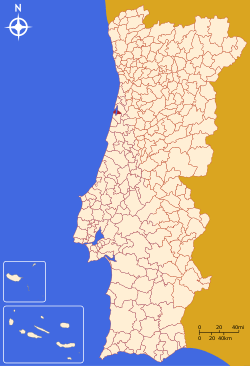Ílhavo Municipality
| Ílhavo | |||
|---|---|---|---|
| Municipality | |||
| |||
 | |||
| Coordinates: 40°36′N 8°40′W / 40.600°N 8.667°WCoordinates: 40°36′N 8°40′W / 40.600°N 8.667°W | |||
| Country |
| ||
| Region | Centro | ||
| Subregion | Baixo Vouga | ||
| District/A.R. | Aveiro | ||
| Government | |||
| • Mayor | José Esteves (PSD) | ||
| Area | |||
| • Total | 75 km2 (29 sq mi) | ||
| Population | |||
| • Total | 37,209 | ||
| • Density | 496/km2 (1,280/sq mi) | ||
| Parishes (no.) | 4 | ||
| Municipal holiday |
Easter Monday date varies | ||
| Website | http://www.cm-ilhavo.pt | ||
Ílhavo Municipality (Portuguese pronunciation: [ˈiʎɐvu] (![]() )) is located in Aveiro District, in Baixo Vouga Subregion, by the Ria de Aveiro and the Atlantic Ocean, with an area of 75 km2 (29 sq mi) and a population of 37,209, distributed by four parishes. The registered population density is 496 inhabitants/km².
)) is located in Aveiro District, in Baixo Vouga Subregion, by the Ria de Aveiro and the Atlantic Ocean, with an area of 75 km2 (29 sq mi) and a population of 37,209, distributed by four parishes. The registered population density is 496 inhabitants/km².
The municipality of Ílhavo includes two cities: Gafanha da Nazaré (about 15,000 inhabitants) and Ílhavo (around 17,000 residents).
Demographics
| Population of Ílhavo Municipality (1801–2008) | ||||||||
|---|---|---|---|---|---|---|---|---|
| 1801 | 1849 | 1900 | 1930 | 1960 | 1981 | 1991 | 2001 | 2008 |
| 5 436 | 6 797 | 13 163 | 17 709 | 25 108 | 31 383 | 33 235 | 37 209 | 41 271 |
Parishes
- Gafanha da Encarnação
- Gafanha da Nazaré
- Gafanha do Carmo
- Ílhavo (São Salvador)
Cities and towns
There are two cities in the municipality.
- Gafanha da Nazaré (city)
- Ílhavo (city)
Civic information
Ílhavo received its rights on 13 October 1296 from King Denis of Portugal and is composed of four parishes. The city lies within the District of Aveiro. On 9 August 1990, it was elevated to the rank of a city. José Agostinho Ribau Esteves of the Social Democratic Party is the Mayor. There are 28,749 people eligible to vote (2006). The municipal holiday is Easter Monday.
Tourism

Within the municipality, there are two villages that are popular in the summertime: Praia ("beach") da Barra, where the tallest lighthouses in Portugal (Farol de Aveiro ou da Barra) is situated and Praia da Costa Nova (Costa Nova do Prado), with its typical houses called Palheiros (they are characterized for fronts in wood or concrete, listed with lively and cheerful colors alternated with the white color) and fish market.


In Barra, one can find the tallest Portuguese lighthouse (62 metres from the ground but 66 metres above sea level). It was built between 1885 and 1893. The light can cast as far as 26 nautical miles out to sea (approx. 48 km).
Ílhavo is deeply connected with the fishing of codfish; with effect most of the captains were original of there. These connections of Ílhavo with the sea can be seen in the Museum Maritímo de Ílhavo, which for besides the building, there has the only side surviving tug of fishing of the cod. The ship makes integrant part of the Museum and provides lodging for temporary exhibitions. The recently renovated Maritime Museum of Ilhavo is dedicated to the White Fleet fisheries and to the Ria de Aveiro fishermen. The main harbor (port) of the region (i.e. Aveiro harbor) is located in Ílhavo municipality.
The city of Ílhavo is famous for his industry of porcelain Vista Alegre, the porcelain company, was founded in the city, where it has its factory.
The city of Ílhavo is known by the famous Bread of Vale de Ílhavo, traditionally handmade and sewed in the firewood oven and also there is the Easter cake or Sweet Bread (with or without eggs) marketed in the heights of the Easter.
The cities of Ílhavo and Aveiro make an urban conurbation and share the lagoon Ria de Aveiro with other nearby municipalities in Baixo Vouga, such as Vagos, Murtosa, Estarreja and Ovar.
External links
| |||||

